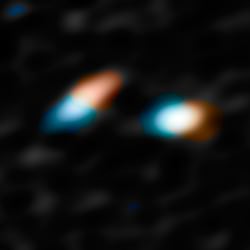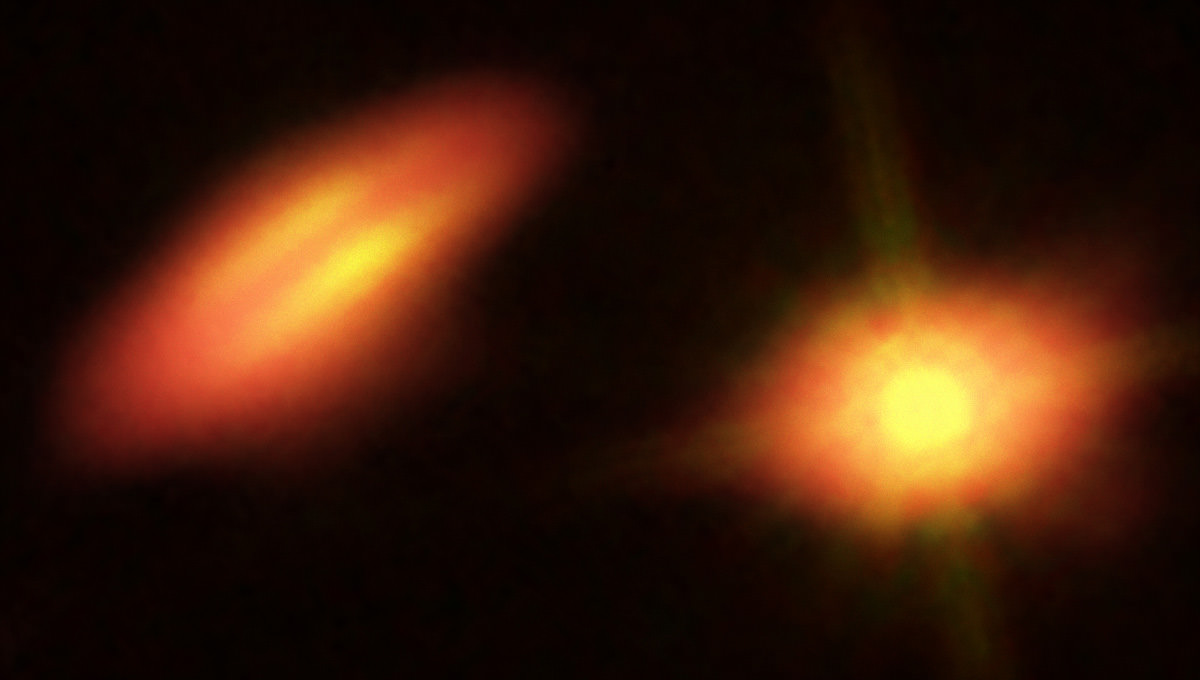When it comes to exoplanets, we’ve discovered an array of extremes — alien worlds that seem more like science fiction than reality. But there are few environments more extreme than a binary star system in which planet formation can occur. Powerful gravitational perturbations from the two stars can easily grind a planet to dust, let alone prevent it from forming in the first place.
A new study has uncovered a striking pair of wildly misaligned planet-forming disks in the young binary star system HK Tau. It’s the clearest picture ever of protoplanetary disks around a double star, shedding light on the birth and eventual orbit of the planets in a multiple star system.
The “Atacama Large Millimeter/submillimeter Array (ALMA) has given us an unprecedented view of a main star and its binary companion sporting mutually misaligned protoplanetary disks,” said Eric Jensen from Swarthmore College in a press release. “In fact, we may be seeing the formation of a solar system that may never settle down.”
The two stars in the system — located roughly 450 light-years away in the constellation Taurus — are less than four million years old and are separated by about 58 billion kilometers, or 13 times the distance of Neptune from the Sun.
ALMA’s high sensitivity and unprecedented resolution allowed Jensen and colleagues to fully resolve the rotation of HK Tau’s two protoplanetary disks.
“It’s easier to observe spread-out gas and dust because it has more surface area – just in the same way that it might be hard to see a small piece of chalk from a distance, but if you ground up the chalk and dispersed the cloud of chalk dust, you could see it from farther away,” Jensen told Universe Today.

The carbon monoxide gas orbits both stars in two broad belts that are clearly rotating — the side spinning away from us is redshifted, while the side spinning toward us is blueshifted.
“What we find in this binary system is that the two orbiting disks are oriented very differently from each other, with about a 60 or 70 degree angle between their orbital planes,” Jensen told Universe Today. Because the disks are so misaligned it’s clear that at least one is also out of sync with the orbit of their host stars.
“This clear misalignment has given us a remarkable look at a young binary star system,” said coauthor Rachel Akeson from the NASA Exoplanet Science Institute at the California Institute of Technology. “Though there have been hints before that this type of misaligned system exists, this is the cleanest and most striking example.”
Stars and planets form out of vast clouds of dust and gas. Small pockets in these clouds collapse under the pull of gravity. But as the pocket shrinks, it spins rapidly, with the outer region flattening into a turbulent disk. Eventually the central pocket becomes so hot and dense that it ignites nuclear fusion — in the birth of a star — while the outer disk — now the protoplanetary disk — begins to form planets.
Despite forming from a flat, regular disk, planets can end up in highly eccentric orbits, and may be misaligned with the star’s equator. One likely explanation is that a binary companion star influences them — but only if its orbit is initially misaligned with the planets.
“Because these disks are misaligned with the binary orbit, then so too will be the orbits of any planets they form,” Jensen told Universe Today. “So in the long run, the binary companion will influence those planet orbits, causing them to oscillate and tend to come more into line with the binary orbit, and at the same time become more eccentric.”
Looking forward, the researchers want to determine if this type of system is typical or not. If it is, then tidal forces from companion stars may easily explain the orbital properties that make the present sample of exoplanets so unlike the planets of our own Solar System.
The results will appear in Nature on July 31, 2014.


“Powerful gravitational perturbations from the two stars can easily grind a planet to dust, let alone prevent it from forming in the first place.”
I think you meant “or even”, not “let alone”.